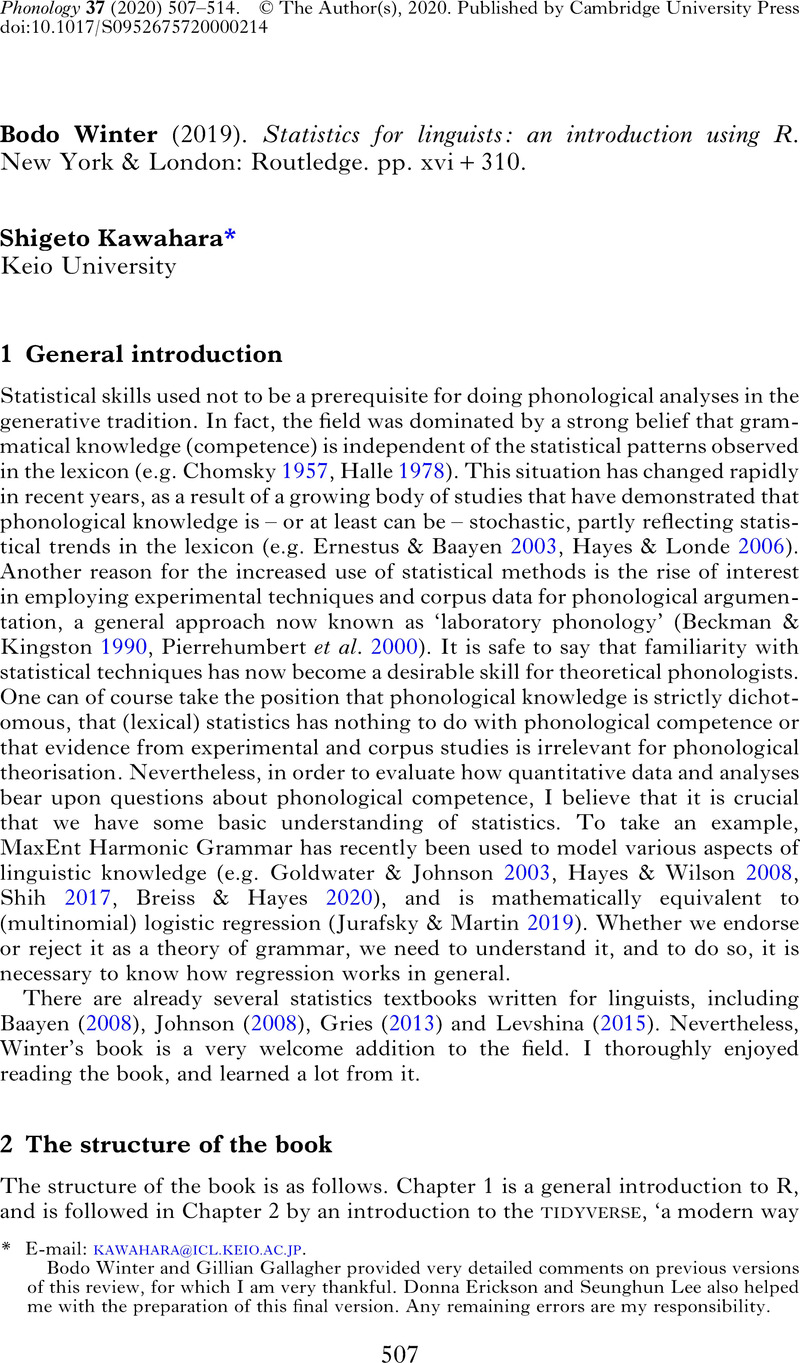No CrossRef data available.
Article contents
Bodo Winter (2019). Statistics for linguists: an introduction using R. New York & London: Routledge. pp. xvi + 310.
Review products
Bodo Winter (2019). Statistics for linguists: an introduction using R. New York & London: Routledge. pp. xvi + 310.
Published online by Cambridge University Press: 10 December 2020
Abstract
An abstract is not available for this content so a preview has been provided. Please use the Get access link above for information on how to access this content.

Information
- Type
- Reviews
- Information
- Copyright
- Copyright © The Author(s), 2020. Published by Cambridge University Press
Footnotes
Bodo Winter and Gillian Gallagher provided very detailed comments on previous versions of this review, for which I am very thankful. Donna Erickson and Seunghun Lee also helped me with the preparation of this final version. Any remaining errors are my responsibility.
References
Baayen, R. Harald (2008). Analyzing linguistic data: a practical introduction to statistics using R. Cambridge: Cambridge University Press.CrossRefGoogle Scholar
Barr, Dale J., Levy, Roger, Scheepers, Christoph & Tily, Harry J. (2013). Random effects structure for confirmatory hypothesis testing: keep it maximal. Journal of Memory and Language 68. 255–278.CrossRefGoogle ScholarPubMed
Beckman, Mary E. & Kingston, John (1990). Introduction. In Kingston, John & Beckman, Mary E. (eds.) Papers in laboratory phonology I: between the grammar and physics of speech. Cambridge: Cambridge University Press. 1–16.Google Scholar
Breiman, Leo (2001). Statistical modeling: the two cultures. Statistical Science 16. 199–231.CrossRefGoogle Scholar
Breiss, Canaan & Hayes, Bruce (2020). Phonological markedness effects in sentence formation. Lg 96. 338–370.Google Scholar
Ernestus, Mirjam & Harald Baayen, R. (2003). Predicting the unpredictable: interpreting neutralized segments in Dutch. Lg 79. 5–38.Google Scholar
Franke, Michael & Roettger, Timo (2019). Bayesian regression modeling (for factorial designs): a tutorial. https://doi.org/10.31234/osf.io/cdxv3.CrossRefGoogle Scholar
Goldwater, Sharon & Johnson, Mark (2003). Learning OT constraint rankings using a Maximum Entropy model. In Spenader, Jennifer, Eriksson, Anders & Dahl, Östen (eds.) Proceedings of the Stockholm Workshop on Variation within Optimality Theory. Stockholm: Stockholm University. 111–120.Google Scholar
Gries, Stefan Th. (2013). Statistics for linguistics with R. 2nd revised edn. Berlin & Boston: De Gruyter Mouton.Google Scholar
Halle, Morris (1978). Knowledge unlearned and untaught: what speakers know about the sounds of their language. In Halle, Morris, Bresnan, Joan & Miller, George A. (eds.) Linguistic theory and psychological reality. Cambridge, Mass.: MIT Press. 294–303.Google Scholar
Hayes, Bruce & Londe, Zsuzsa Cziráky (2006). Stochastic phonological knowledge: the case of Hungarian vowel harmony. Phonology 23. 59–104.CrossRefGoogle Scholar
Hayes, Bruce & Wilson, Colin (2008). A maximum entropy model of phonotactics and phonotactic learning. LI 39. 379–440.Google Scholar
Jurafsky, Daniel & Martin, James H. (2019). Speech and language processing. 3rd edn. Draft available (August 2020) at https://web.stanford.edu/~jurafsky/slp3/.Google Scholar
Levshina, Natalia (2015). How to do linguistics with R: data exploration and statistical analysis. Amsterdam & Philadelphia: Benjamins.CrossRefGoogle Scholar
Pierrehumbert, Janet B., Beckman, Mary E. & Robert Ladd, D. (2000). Conceptual foundations of phonology as a laboratory science. In Burton-Roberts, Noel, Carr, Philip & Docherty, Gerard (eds.) Phonological knowledge: conceptual and empirical issues. Oxford: Oxford University Press. 273–303.Google Scholar
Shih, Stephanie S. (2017). Constraint conjunction in weighted probabilistic grammar. Phonology 34. 243–268.Google Scholar
Vasishth, Shravan, Nicenboim, Bruno, Beckman, Mary E., Li, Fangfang & Kong, Eun Jong (2018). Bayesian data analysis in the phonetic sciences: a tutorial introduction. JPh 71. 147–161.Google ScholarPubMed
Wieling, Martijn (2018). Analyzing dynamic phonetic data using generalized additive mixed modeling: a tutorial focusing on articulatory differences between L1 and L2 speakers of English. JPh 70. 86–116.Google Scholar
Winter, Bodo (2013). Linear models and linear mixed effects models in R with linguistic applications. Available (August 2020) at http://arxiv.org/pdf/1308.5499.pdf.Google Scholar
Winter, Bodo & Wieling, Martijn (2016). How to analyze linguistic change using mixed models, Growth Curve Analysis and Generalized Additive Modeling. Journal of Language Evolution 1. 7–18.CrossRefGoogle Scholar


